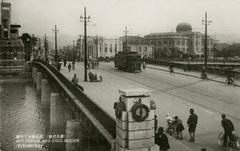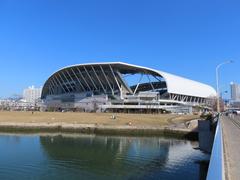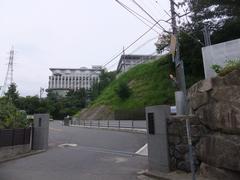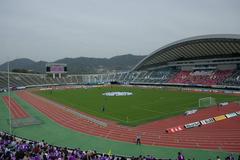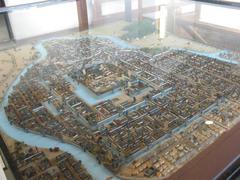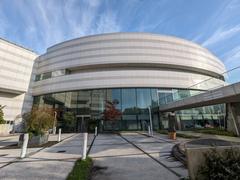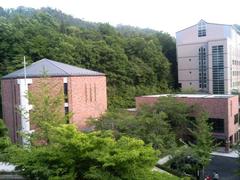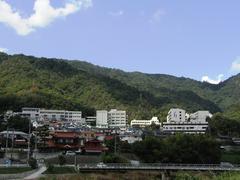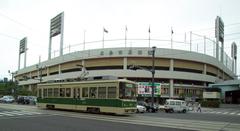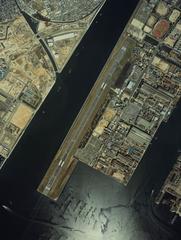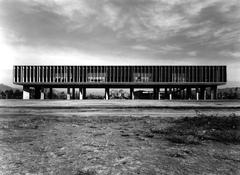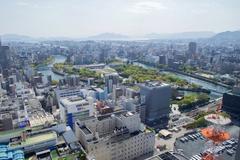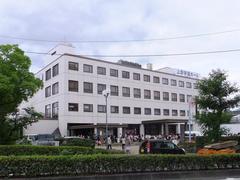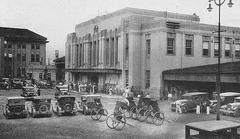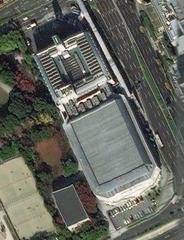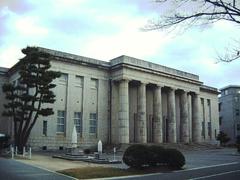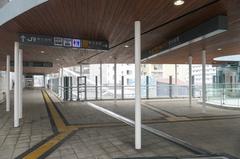
Motoyasu Bridge Visiting Hours, Tickets, and Hiroshima Historical Sites Guide
Date: 04/07/2025
Introduction to Motoyasu Bridge and Its Significance in Hiroshima
Motoyasu Bridge is a poignant historical landmark at the heart of Hiroshima, Japan. Spanning the Motoyasu River beside the Hiroshima Peace Memorial Park, this bridge stands as both an important city connector and a powerful symbol of Hiroshima’s resilience following the atomic bombing on August 6, 1945. First constructed during the Meiji era and rebuilt in the postwar years, Motoyasu Bridge has witnessed Hiroshima’s evolution from a bustling commercial center in the Edo period to a modern city dedicated to peace and remembrance. Its proximity to the UNESCO-listed Atomic Bomb Dome and its role in memorial events highlight its enduring cultural and symbolic importance.
Open to the public at all times, Motoyasu Bridge invites visitors to reflect on Hiroshima’s complex past while enjoying sweeping views of the city’s most significant historical landmarks. This guide offers comprehensive information on Motoyasu Bridge visiting hours, ticket details, accessibility, nearby attractions, travel tips, and recommendations for a meaningful visit.
For more about the bridge’s history and details on visiting, refer to official resources such as the Hiroshima Peace Memorial Museum, Dive Hiroshima, and Japan Activity.
Contents
- Introduction
- Origins and Historical Context
- The Atomic Bombing and Aftermath
- Motoyasu Bridge: Historical Background
- Symbolic, Cultural, and Architectural Significance
- Motoyasu Bridge in Today’s Hiroshima
- Visiting Motoyasu Bridge: Hours, Tickets, and Tips
- Visitor Experience and Practical Information
- Special Events and Seasonal Highlights
- Frequently Asked Questions (FAQ)
- Visuals and Media
- Internal Links and Further Reading
- Conclusion and Visitor Recommendations
- References
Origins and Historical Context
Motoyasu Bridge has long played a central role in Hiroshima’s urban life. Located in the Nakajima area—which was a thriving commercial district during the Edo period—the bridge facilitated vital river transport and connected key areas of the city (Japan City Tour). By the Meiji era, Nakajima became Hiroshima Prefecture’s political and commercial core, housing the City Hall and Prefectural Office.
The Atomic Bombing and Immediate Aftermath
On August 6, 1945, Hiroshima was devastated by the world’s first atomic bombing. The bomb’s hypocenter was near the Motoyasu River, and the explosion resulted in immense destruction and loss of life, including the Nakajima district and its infrastructure (Pragmatika Media). The Motoyasu Bridge, only 160 meters from ground zero, survived in a damaged state and became a symbol of the city’s endurance and hope.
Motoyasu Bridge: Historical Background
Originally constructed in 1873, Motoyasu Bridge was a part of Hiroshima’s modernization drive. The bridge has been reconstructed several times—most notably after World War II and again in 1992 to address deterioration—while retaining elements from previous structures, such as columns and pillars, as historical monuments (Hiroshima Peace Memorial Museum). Its location just south of the atomic bomb’s hypocenter underscores its symbolic importance in the city’s narrative.
Symbolic, Cultural, and Architectural Significance
A Witness to History
Motoyasu Bridge sits adjacent to the Hiroshima Peace Memorial Park and faces the Atomic Bomb Dome. Many survivors (hibakusha) crossed the bridge seeking aid after the bombing, cementing its role as a route of escape and hope.
Memorial and Cultural Functions
The bridge is integral to the annual Hiroshima Peace Memorial Ceremony each August 6, when thousands cross to participate in commemorations and the lantern floating ceremony on the river—a moving tribute for peace and remembrance (Japan Activity).
Architectural Features
The current bridge, completed in 1992, mirrors the original design and includes original columns and pillars. It is 100 meters long and 18 meters wide, with broad walkways offering panoramic views of the Atomic Bomb Dome, Motoyasu River, and Peace Memorial Park.
Motoyasu Bridge in Today’s Hiroshima
Gateway to Peace Memorial Park
Motoyasu Bridge is the primary pedestrian entrance to Hiroshima Peace Memorial Park, connecting visitors directly to sites such as the Children’s Peace Monument and Peace Memorial Museum.
Urban Connectivity
Beyond its symbolic status, the bridge is a vital artery linking Hiroshima’s commercial and cultural zones, forming part of routes for city festivals and public events (Japan Activity).
Visiting Motoyasu Bridge: Hours, Tickets, and Tips
Visiting Hours and Tickets
- Hours: Open 24/7; no admission fee.
- Nearby Attractions: Many, such as the Peace Memorial Museum, have set opening hours (generally 8:30 a.m.–6:00 p.m.) and require tickets. Always check official sites for current info.
Accessibility
Motoyasu Bridge is fully accessible to pedestrians, cyclists, and visitors with mobility challenges. The nearest tram stop, Genbaku Dome-mae, is a short walk away. The Meipuru-pu Sightseeing Loop Bus also serves the area and is free for Japan Rail Pass holders (Nerd Nomads).
Travel Tips
- Early morning and late afternoon provide the best light for photos.
- Spring (March–May) and autumn (October–November) offer pleasant weather and beautiful scenery, especially cherry blossoms and autumn foliage (TripSavvy).
- The area is safe and well-lit, but daytime visits are recommended for the best experience.
Visitor Experience and Practical Information
Scenic Views and Photo Opportunities
The bridge offers iconic views of the Atomic Bomb Dome and Peace Memorial Park. Cherry blossom season in early April and autumn color changes are especially photogenic.
Walking and Cycling
With wide walkways and gentle inclines, Motoyasu Bridge is pedestrian- and wheelchair-friendly. Many guided walking and cycling tours include the bridge as a key stop, offering in-depth historical context (Nerd Nomads).
Memorial Elements
The bridge incorporates original columns and has nearby historic monuments, connecting visitors with Hiroshima’s past (Hiroshima Peace Memorial Museum).
Nearby Amenities
Public restrooms, benches, cafes, and convenience stores are located around the bridge and Peace Memorial Park. Hondori Street, a lively shopping and dining arcade, is a 10-minute walk away.
Special Events and Seasonal Highlights
- August 6: The bridge is a central site for the Hiroshima Peace Memorial Ceremony and lantern floating.
- Spring/Autumn: Cherry blossoms and autumn leaves transform the views.
- Winter: Illuminations create a festive evening atmosphere (Nerd Nomads).
Frequently Asked Questions (FAQ)
Q: What are the visiting hours for Motoyasu Bridge?
A: Motoyasu Bridge is open 24 hours daily; no ticket is required.
Q: Is there an admission fee for the bridge?
A: No, access is free.
Q: How do I get to Motoyasu Bridge?
A: Take tram lines 2 or 6 to Genbaku Dome-mae or Otemachi stops, or use the Meipuru-pu bus.
Q: Are there guided tours?
A: Yes, many local operators and online platforms offer guided walking and cycling tours that include the bridge.
Q: Is the bridge accessible for wheelchairs and strollers?
A: Yes, the walkways are wide and smooth.
Visuals and Media
Include high-quality images of Motoyasu Bridge in different seasons, with descriptive alt text like “Motoyasu Bridge Hiroshima cherry blossoms” or “Motoyasu Bridge view of Atomic Bomb Dome.” Interactive maps and virtual tours are recommended for enhanced trip planning.
Internal Links and Further Reading
Conclusion and Visitor Recommendations
Motoyasu Bridge is a living monument to Hiroshima’s resilience, peace-building, and historical memory. Open 24/7 with free access, it is an essential stop for visitors seeking to understand the city’s legacy. For an enriched experience, consider joining a guided tour, attend key memorial events, and explore the surrounding historical sites. Download the Audiala app for guided audio tours and interactive maps, and follow local tourism platforms for updates.
Motoyasu Bridge invites visitors to connect with history, reflect on peace, and witness the enduring spirit of Hiroshima. For further planning, consult resources like Japan City Tour, Nerd Nomads, and the Hiroshima Peace Memorial Museum.
References
- This article draws on official resources and visitor guides, including:
- Motoyasu Bridge in Hiroshima: A Historical Landmark and Visitor’s Guide to Hiroshima Historical Sites, 2025, Japan City Tour (https://japancitytour.com/hiroshima-peace-memorial-park/)
- Motoyasu Bridge in Hiroshima: Visiting Hours, Tickets, and Historical Significance, 2025, Dive Hiroshima (https://dive-hiroshima.com/en/feature/feature-92844/)
- Motoyasu Bridge in Hiroshima: Visiting Hours, Tickets, and Historical Significance, 2025, Japan Activity (https://japanactivity.com/hiroshima-events/)
- Visiting Motoyasu Bridge: Hours, Tickets, and Guide to Hiroshima’s Historical Gem, 2025, Nerd Nomads (https://nerdnomads.com/hiroshima-itinerary)
- Motoyasu Bridge Visiting Hours, Tickets & Guide to Hiroshima Historical Sites, 2025, Hiroshima Peace Memorial Museum (http://www.pcf.city.hiroshima.jp/virtual/map-e/irei/tour_44_e.html)






